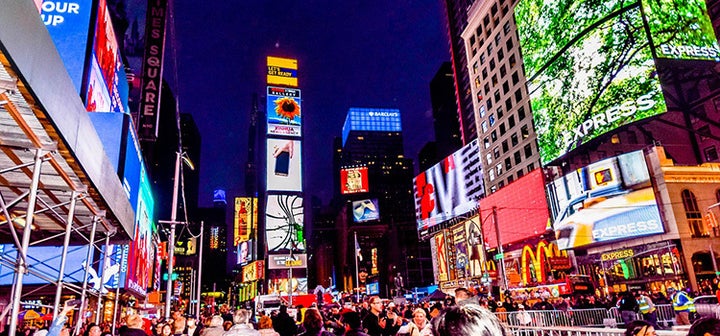
The perception might be that only local personal injury lawyers advertise on billboards in the modern era of advertising, but that would be wrong. Despite not being as cutting edge as online advertising, the billboard industry has grown steadily since 2008 while other “old” mediums like newspaper and radio ads have declined.
Part of that growth is that billboards still have a captive audience whereas fewer people tune into local radio anymore. Another part is that billboards have worked to reinvent themselves, many of them going digital and providing marketers with detailed information about traffic volume that will see their ads. But that effort to modernize is getting a shot in the arm from a technology trend called targeted Digital Out of Home (DOOH) advertising.
What this technology does is capture smartphone data in a physical space near a digital sign to paint a picture of what the crowd of people is like. Smartphones are constantly pinging wifi routers looking for a network, and those pings can be paired to existing advertising IDs. These IDs report an anonymous profile of information about search history, consumer behavior, and use of mobile applications. Based on that, companies can aggregate crowd demographics to inform the digital sign which ad it should display.
I wanted to know more about the impact this would have on the advertising we see around us so I connected with Jon Frangakis, co-founder and CEO of Mira, a targeted DOOH company.

Jon Frangakis, Co-founder & CEO of Mira
Q: The idea of targeted Digital Out of Home advertising sounds very futuristic, but the technology is here today. Would the average person ever notice a difference like they do when they are retargeted by ads online?
Frangakis: The goal is that the ads we see in the world around us happen to be more meaningful. Crowd analytics is sort of a process to manufacture serendipity. We increase the chance that the message our clients are delivering is the one that will resonate most strongly with the group of people looking at it.
We worked on a car campaign a few months ago that helps illustrate this pretty clearly. It was a buy that took place in malls so we looked at our data from those malls historically and noticed that auto-intenders (people who’d likely be in the market for a car in the next 6 months) had a tendency to fall into 3 sub audiences. They were “Young Adventurers” which corresponded to the 22 – 30 year old end of the millennial generation, “Traditionalists”, which were essentially baby boomers, and “Luxury”, which is pretty self explanatory.
Understanding that each sub-audience would have a different reason for wanting to buy a car, we worked with the agency to identify those. The Young Adventurers would see creative that focused on technology like phone integration and had a fun/younger feel, Traditionalists saw something geared towards 3rd row seating and safety because they’re all having grandkids, and the Luxury audience was more about the luxury package and options.
All we had to do was measure the average consumer at a given location in real time and render a decision as to which one of those audiences would have the strongest or broadest appeal. Conversions go up and the client thinks it’s magic. But it’s just data.
Q: Are there data or case studies to suggest how much of an impact this can have on the effectiveness of marketing?
Frangakis: Yes there are. We have done pretty rigorous experiments measuring everything from web conversions to foot traffic increases to brand recall. The common theme tends to hover around a 63% increase in the efficiency of creative optimization over a control group. We’re actually conducting a major test right now which could show a nearly 100% increase.
The reason it works is because out of home is an effective medium and Crowd Analytics provides a deep understanding of the composition of the audience looking at a screen while remaining anonymous and avoiding creepiness. This platform was built from day one to respect the privacy of our audiences and provide incremental optimizations over today’s solutions.
Q: Do the companies you talk to struggle to see the vision or are they ready for this technology?
Frangakis: Not everyone gets it. I think the 80/20 rule applies to selling innovation as well. Generally, 20% of the folks you talk to will welcome what you’re doing in the name of progress. The other 80% will reject it based on (1) lack of understanding, (2) lack of desire to do something out of their comfort zone, or (3) inability to champion your cause at their organization.
The good part about that is that the 20% who see the value in what we do are people who have had success in bringing innovation to this industry. If we can repeat some of their results, another 20% of the remaining 80% will now be customers, and so on.
Q: Where does targeted DOOH go in the next five years? What is the next leap forward?
Frangakis: There are seismic changes on just the one year horizon in DOOH. For the past 26 straight quarters the industry has experienced steady growth, most recently driven by the proliferation of digital panels, data-centric planning tools and dynamic CMS configurations. Even while other traditional media are shrinking, Out of Home continues to grow.
But the Cambrian Moment hasn’t happened yet and we’re betting that it’s just around the corner. To understand the opportunity at DOOH’s door, I like to look at a few other trends first. According to modest estimates, Ad Blockers are going to cost the ad industry upwards of $35B in 2020. That’s the equivalent of 10x the current DOOH industry in the US disappearing in a single year.Transparency and Viewability was a $10B problem in 2016 and fraudulent impressions was $7.2B.
There are major shifts occurring internal to Out of Home that are driving the change towards the future we see for the industry:
- Agencies talked about buying audiences instead of locations this year more than they ever have in previous years. This increasing sophistication is foundational to the coming shifts in how the medium is packaged and bought.
- Almost every digital screen out there is addressable and connected now. This is obviously core to dynamic ad serving
- And obviously the arrival of a nimble, data-centric startup like Mira that turns physical crowds of people into segmented audiences. In lieu of place-based, which is a common term in our industry, these people-based networks are able to drive OOH screens based on real time measurement of audience composition.
Steve Case would call what has happened in our industry over the last few years the first wave of OOH (foundation laying) and what’s about to happen (building businesses on top of that foundation) the 2nd wave. Soon OOH will make claims we’ve never been able to make before: efficiency, waste reduction, and something better than putting up a generic piece of creative and hoping that one size fits some.
